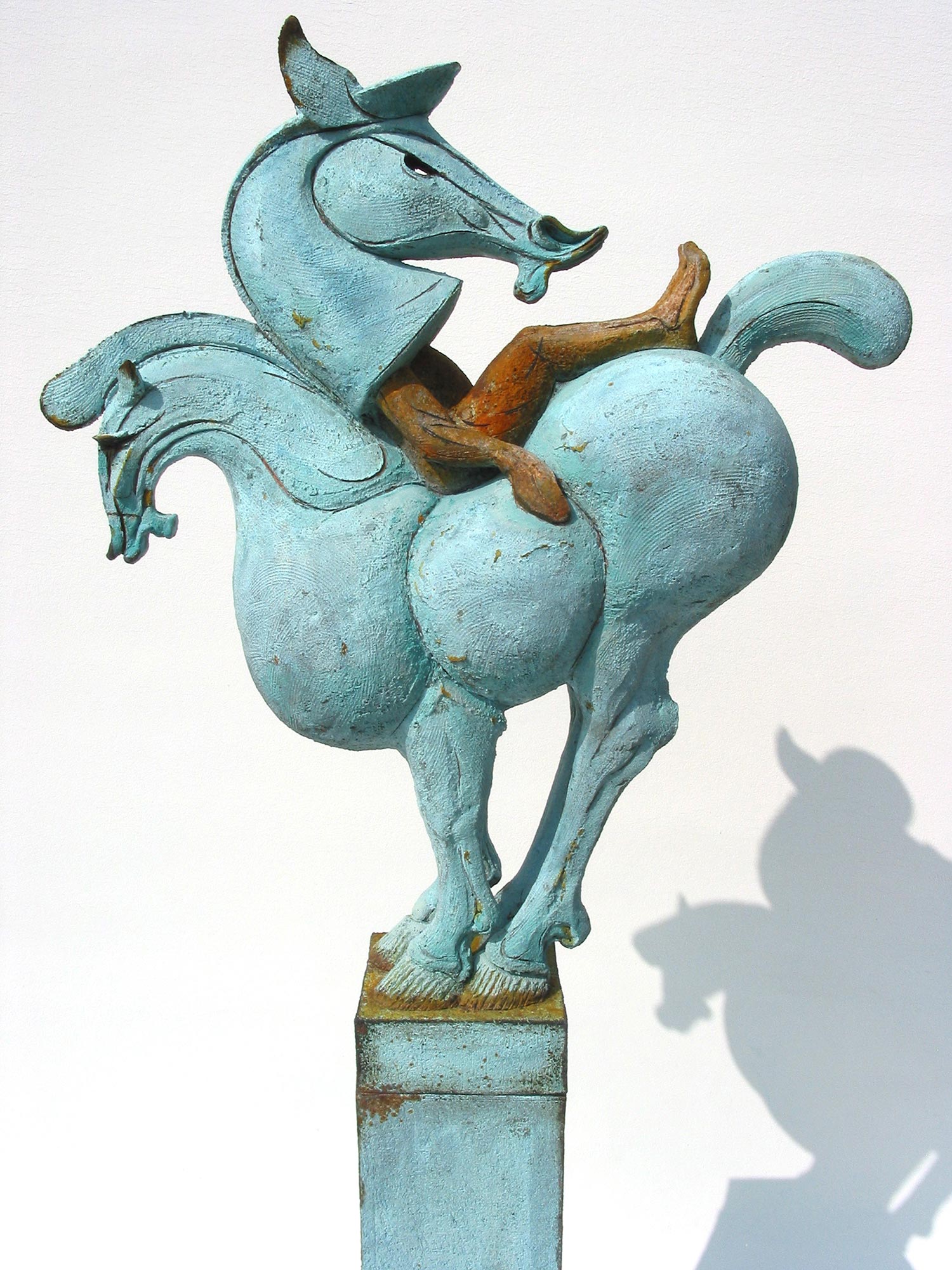
Once I Sat Upon a Promontory (Detail) ©
111 cm high x 50 cm wide
Unique

In much of this work Diamantopoulo plays with the irony of the ‘plinth-as- hero’.
“With the advent of the Fourth Plinth at Trafalgar Square, the plinth has re- established itself in the mind of the contemporary artist, when in recent decades it was so easily snubbed as a relic of a bygone statuary art form.
“For me, it was never out of place in the gallery or street and I find it amusing that it is still happily underpinning many figurative and conceptual art forms. “
Here, the plinth, pillar or mount becomes the story, an essential part of the message.

Once I Sat Upon a Promontory ll ©
115 cm high x 50 cm wide
Unique
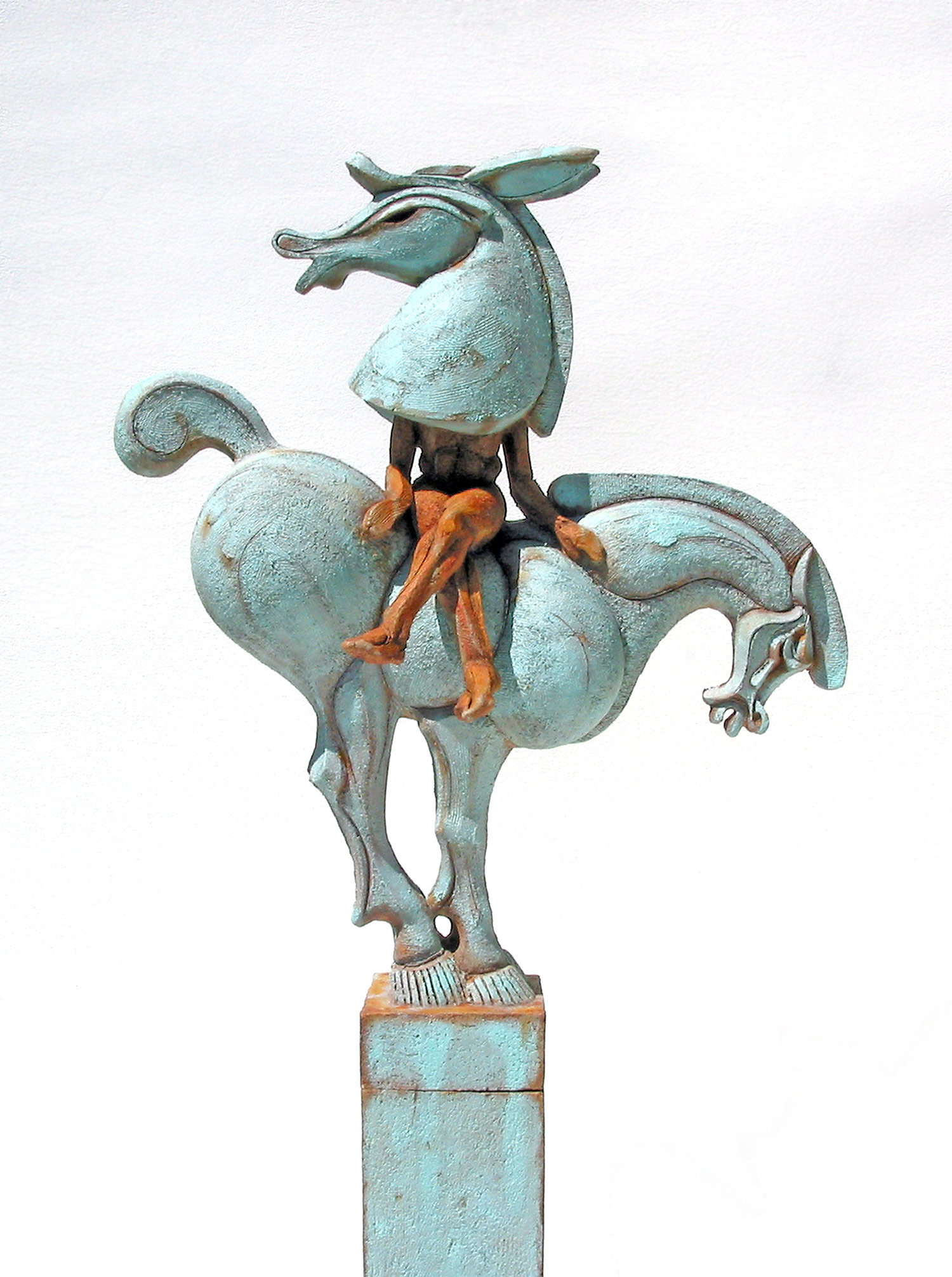
“The notion of putting a Bottom in repose, on a pedestal appealed to my sense of the absurd – making the misplaced à propos and credible.”
This work alludes to Oberon’s speech to Puck in Shakespeare’s Midsummer Night’s Dream where Bottom’s fate is sealed.
Chronologically, of course, the small- headed Tang Horse doesn’t belong in this story, though somehow, it sits well together.
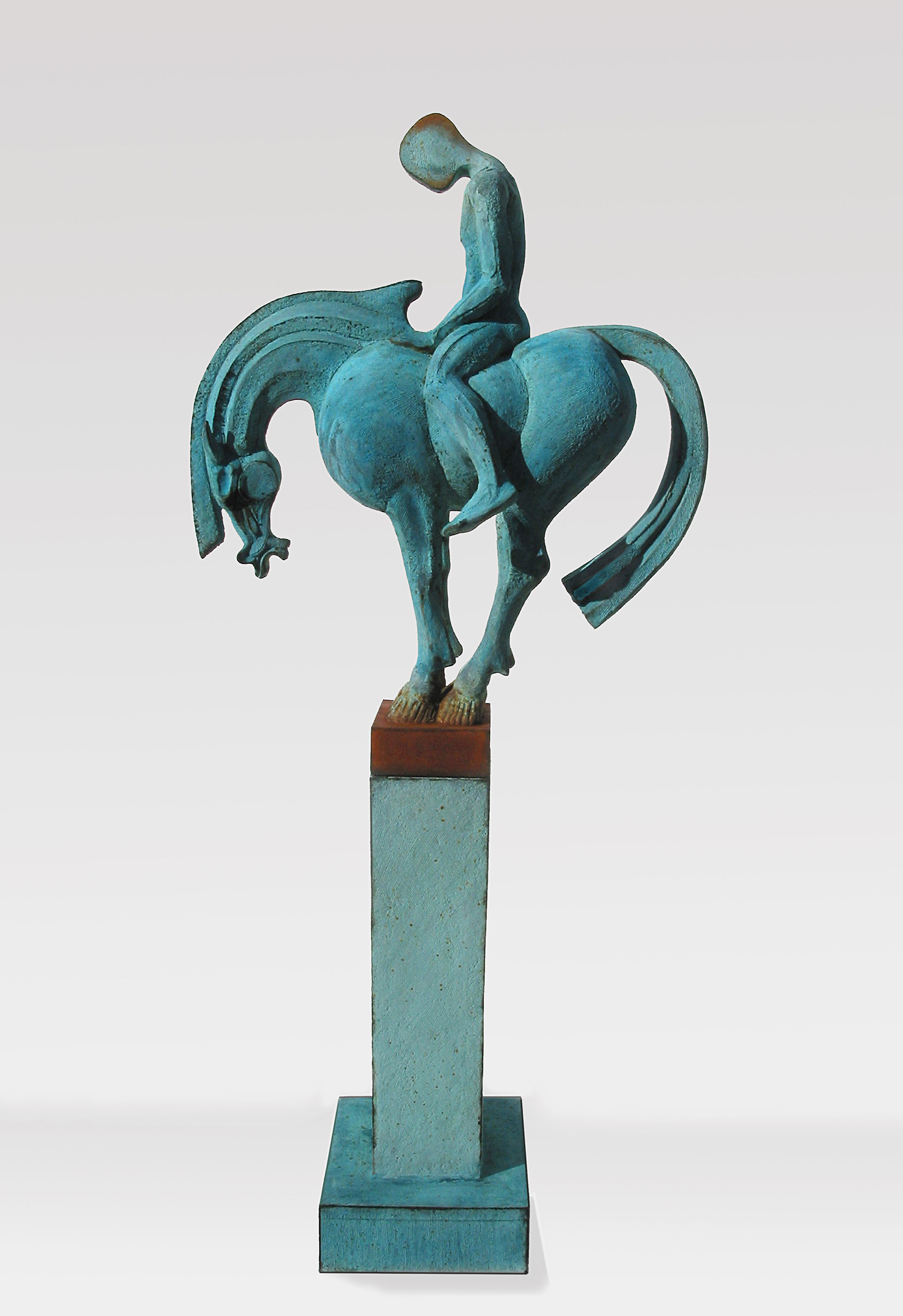
Tang Blue ©
118 cm high x 51 cm wide
Unique
Diamantopoulo has taken the basic long-necked Tang Horse form and counter-balanced it, more or less exactly, with an atypical extended tail so that it stands precariously like a vase on a plinth – yet seems perfectly composed in the restful sense.
The horse and rider are blue - in the R&B sense.

(Detail) Tang Blue ©
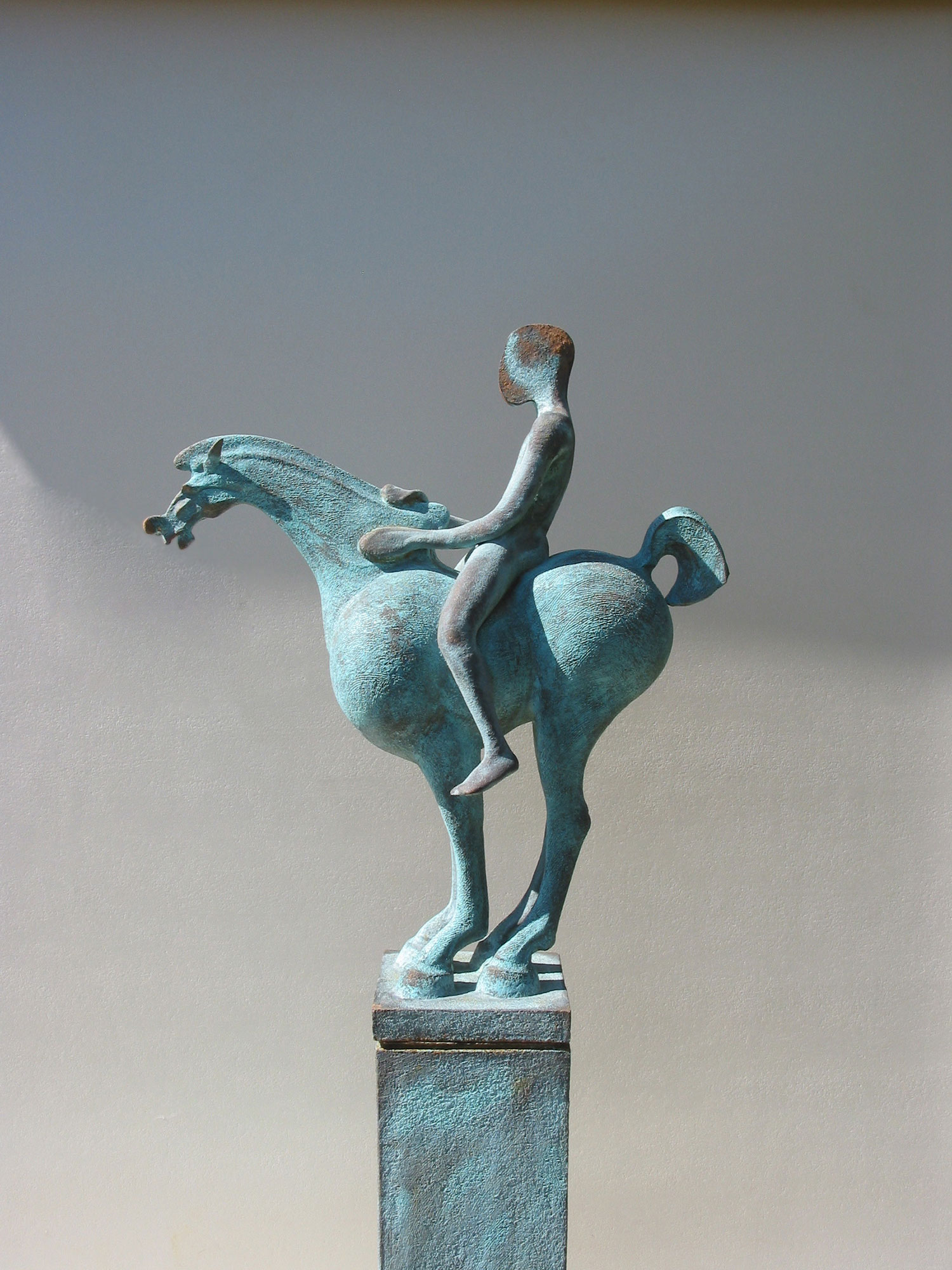
Chloros ©
126 cm high x 50 cm wide
Unique
Chlorus - Greek lexicon for pale green. The piece takes its energy from a Chinese dynamic, though paradoxically it is hauntingly still.
The horse’s head is diminutive - a classical technique which enhances presence in the body.
Though it is not apparent from this angle, viewed face-on, in both Tang Blue and this sculpture, the figure’s head is pared down to a mere slice, sitting on the shoulders like a penny - perhaps a gradual path to abstraction.

Baroque and Berserque ©
160 cm high x 69 cm wide
Unique
Embellished and extravagant in style in the baroque sense, but equally sketchy and free - a barmy concoction of creatures: avian, equine and seemingly cloven-hoofed.
Perfectly balanced on a pedestal, but equally off-his-rocker, this is a cock- eyed horse with a precocious, come- hither haunch.
A guardian of the gates of Bedlam perhaps.
Roy Harper fans will recognise the modified title (sic) from an album of the same name.
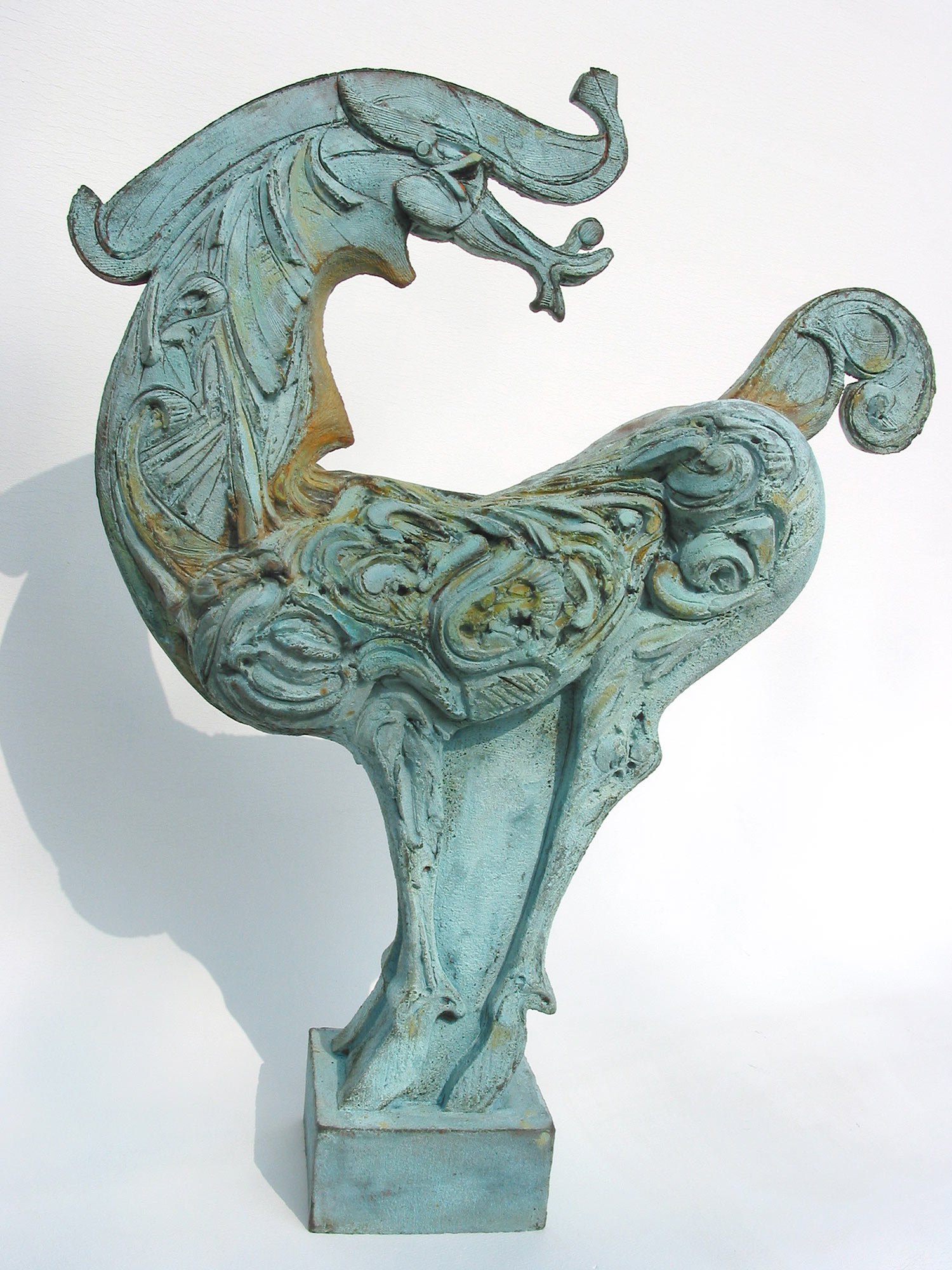
Baroque and Berserque (Detail) ©

Moondancer ©
77 cm high x 38 cm wide
Unique
A turbaned head and mane has been added to this Chinese-Moghul crossbreed to create a vessel-of-a- horse with two handles.
“The Pasha’s Delight” was in my mind when making this tail-eating horse. High-spirited and corpulent, prancing improbably on a half moon, he exudes exoticism.

Moondancer ll ©
95.5 cm high x 67 cm wide
Unique

Bucephalus ©
79 cm high x 94 cm wide
Unique
Subverting the concept of the horse as the object being mounted - it is the horse that is now mounted on a pedestal or, as in this case, a pedestal masquerading as a vessel.
The horse as passenger and not as conveyor and the vessel as a means of bearing the noble creature aloft, is a recurring theme.
Here, Bucephalus, Alexander the Great’s favourite horse, travels down the Nile on a royal, reed, horse- barge.
It is no accident that the barge also mimics a blacksmith’s anvil.
The ‘anvil’ anchors the piece, accentuating its gravitas whilst negating any sense of floatation.

Equuleus ©
96 cm high x 134 cm wide
Unique
Equuleus (Little Horse) perhaps representing the bringer of war.
This creature is poised for power, seemingly bearing a helmet or plating of some kind - a fearful and ancient deliverance upon some unsuspecting present-day shore.
Diamantopoulo deliberately launches classical or antiquarian themes or forms into the contemporary space in order to provoke.
A thing of beauty can deliver a disturbing sub- text with all the more force.

King Creole ©
87 cm high x 66 cm wide
Unique
Flying over a Norse-like vessel, a Celtic war-horse – simple, like an iron-age chalk downs carving, gallops with a standing rider on board.
The rider is based on the cave scratching of an even earlier art form to become a Neolithic King with an Elvis quiff or a primitive mouth.
The weathervane arms point east and west and echo the Christian cross.
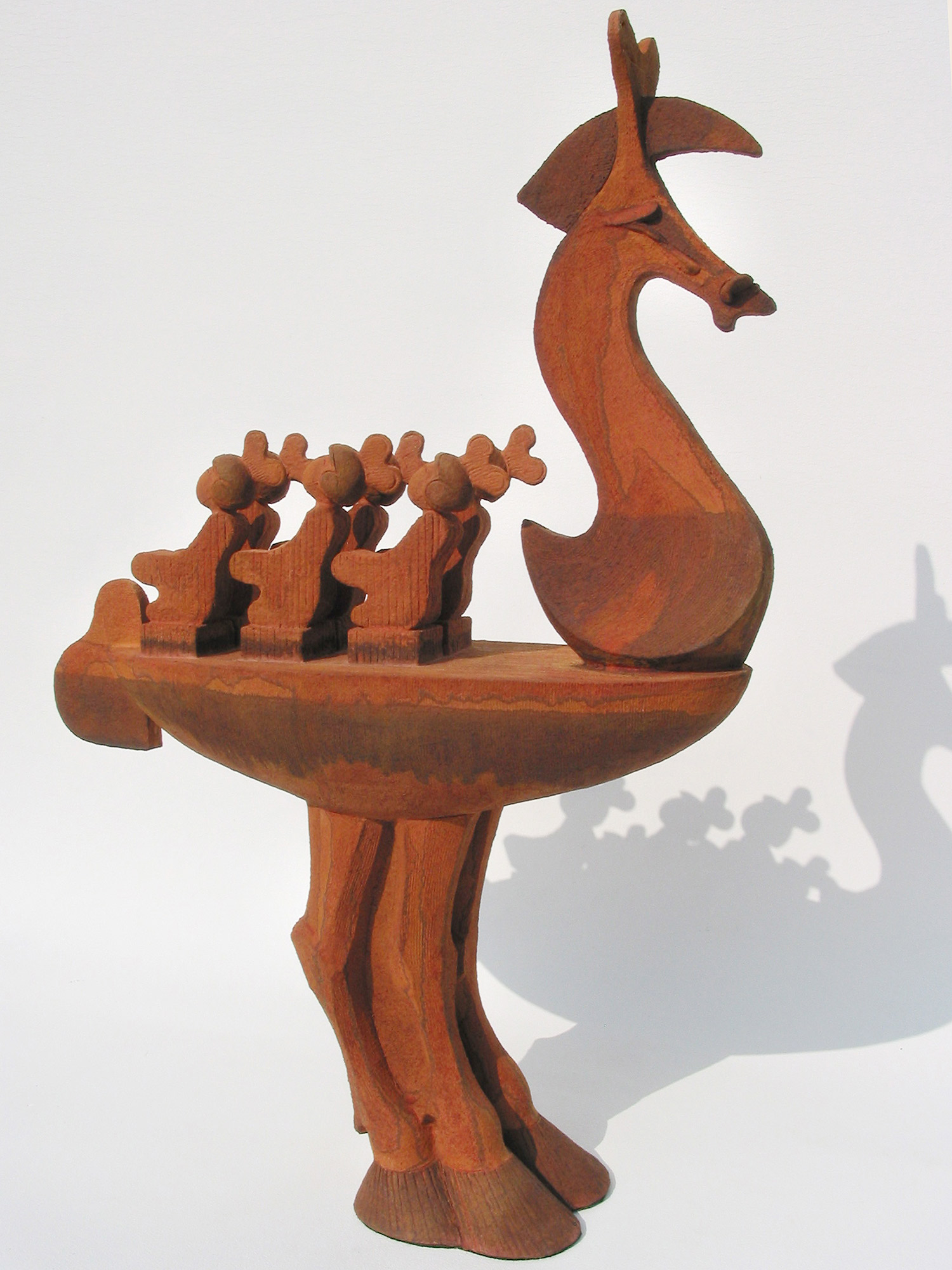
Seahorse ©
79 cm high x 54 cm wide
Unique
A vessel with a horse-head prow and a horse-legged stand; on board, six rowers of Chinese origin.
Understated in this eclectic mix are the the horsetail rudder and the heart-shaped helmets that are disguised, wind-up toy keys.
This piece implies deception, combining the charm of a mechanical toy with the presence of an instrument of plunder. A variation on a Greek offering.

The Happy Han ©
74 cm high x 38 cm wide
Unique
“I wanted to simplify the horse form here. The result is easy on the eye – and jolly. Hence the name.”
















Once I Sat Upon a Promontory (Detail) ©
111 cm high x 50 cm wide
Unique
In much of this work Diamantopoulo plays with the irony of the ‘plinth-as- hero’.
“With the advent of the Fourth Plinth at Trafalgar Square, the plinth has re- established itself in the mind of the contemporary artist, when in recent decades it was so easily snubbed as a relic of a bygone statuary art form.
“For me, it was never out of place in the gallery or street and I find it amusing that it is still happily underpinning many figurative and conceptual art forms. “
Here, the plinth, pillar or mount becomes the story, an essential part of the message.
Once I Sat Upon a Promontory ll ©
115 cm high x 50 cm wide
Unique
“The notion of putting a Bottom in repose, on a pedestal appealed to my sense of the absurd – making the misplaced à propos and credible.”
This work alludes to Oberon’s speech to Puck in Shakespeare’s Midsummer Night’s Dream where Bottom’s fate is sealed.
Chronologically, of course, the small- headed Tang Horse doesn’t belong in this story, though somehow, it sits well together.
Tang Blue ©
118 cm high x 51 cm wide
Unique
Diamantopoulo has taken the basic long-necked Tang Horse form and counter-balanced it, more or less exactly, with an atypical extended tail so that it stands precariously like a vase on a plinth – yet seems perfectly composed in the restful sense.
The horse and rider are blue - in the R&B sense.
(Detail) Tang Blue ©
Chloros ©
126 cm high x 50 cm wide
Unique
Chlorus - Greek lexicon for pale green. The piece takes its energy from a Chinese dynamic, though paradoxically it is hauntingly still.
The horse’s head is diminutive - a classical technique which enhances presence in the body.
Though it is not apparent from this angle, viewed face-on, in both Tang Blue and this sculpture, the figure’s head is pared down to a mere slice, sitting on the shoulders like a penny - perhaps a gradual path to abstraction.
Baroque and Berserque ©
160 cm high x 69 cm wide
Unique
Embellished and extravagant in style in the baroque sense, but equally sketchy and free - a barmy concoction of creatures: avian, equine and seemingly cloven-hoofed.
Perfectly balanced on a pedestal, but equally off-his-rocker, this is a cock- eyed horse with a precocious, come- hither haunch.
A guardian of the gates of Bedlam perhaps.
Roy Harper fans will recognise the modified title (sic) from an album of the same name.
Baroque and Berserque (Detail) ©
Moondancer ©
77 cm high x 38 cm wide
Unique
A turbaned head and mane has been added to this Chinese-Moghul crossbreed to create a vessel-of-a- horse with two handles.
“The Pasha’s Delight” was in my mind when making this tail-eating horse. High-spirited and corpulent, prancing improbably on a half moon, he exudes exoticism.
Moondancer ll ©
95.5 cm high x 67 cm wide
Unique
Bucephalus ©
79 cm high x 94 cm wide
Unique
Subverting the concept of the horse as the object being mounted - it is the horse that is now mounted on a pedestal or, as in this case, a pedestal masquerading as a vessel.
The horse as passenger and not as conveyor and the vessel as a means of bearing the noble creature aloft, is a recurring theme.
Here, Bucephalus, Alexander the Great’s favourite horse, travels down the Nile on a royal, reed, horse- barge.
It is no accident that the barge also mimics a blacksmith’s anvil.
The ‘anvil’ anchors the piece, accentuating its gravitas whilst negating any sense of floatation.
Equuleus ©
96 cm high x 134 cm wide
Unique
Equuleus (Little Horse) perhaps representing the bringer of war.
This creature is poised for power, seemingly bearing a helmet or plating of some kind - a fearful and ancient deliverance upon some unsuspecting present-day shore.
Diamantopoulo deliberately launches classical or antiquarian themes or forms into the contemporary space in order to provoke.
A thing of beauty can deliver a disturbing sub- text with all the more force.
King Creole ©
87 cm high x 66 cm wide
Unique
Flying over a Norse-like vessel, a Celtic war-horse – simple, like an iron-age chalk downs carving, gallops with a standing rider on board.
The rider is based on the cave scratching of an even earlier art form to become a Neolithic King with an Elvis quiff or a primitive mouth.
The weathervane arms point east and west and echo the Christian cross.
Seahorse ©
79 cm high x 54 cm wide
Unique
A vessel with a horse-head prow and a horse-legged stand; on board, six rowers of Chinese origin.
Understated in this eclectic mix are the the horsetail rudder and the heart-shaped helmets that are disguised, wind-up toy keys.
This piece implies deception, combining the charm of a mechanical toy with the presence of an instrument of plunder. A variation on a Greek offering.
The Happy Han ©
74 cm high x 38 cm wide
Unique
“I wanted to simplify the horse form here. The result is easy on the eye – and jolly. Hence the name.”